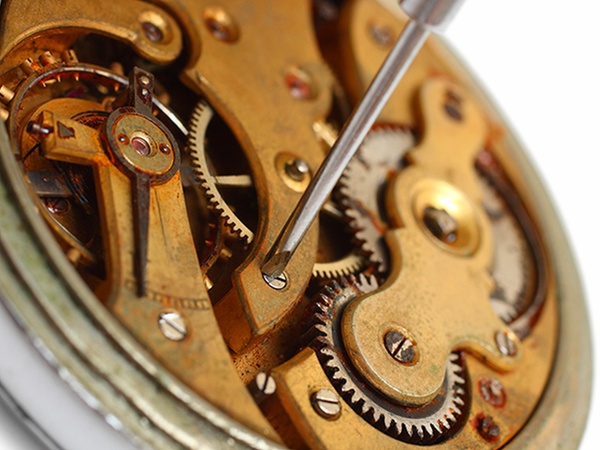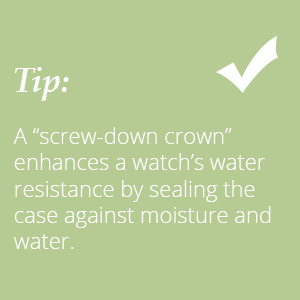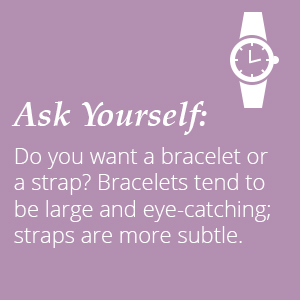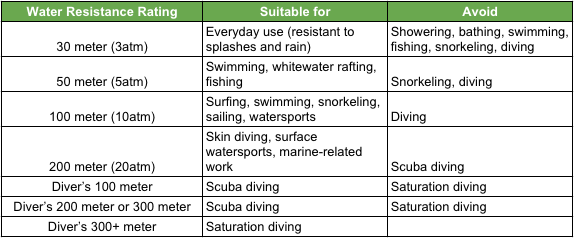
Even in the age of smartphones, a good watch can be an essential part of your wardrobe. But with all the types of watches out there and all the strange terminology that accompanies them, it’s hard to know exactly what to look for when you’re in the market for a timepiece. Read on for a guide to a watch’s parts and their functionality—which can extend far beyond basic timekeeping.
Movement
One of the main considerations when buying a watch is its movement: literally, what makes it tick.
Manual Mechanical
Now produced mostly as a luxury item, manual mechanical watches have been around since the 17th century, when watchmakers miniaturized the timekeeping technology used in clocks. Inside a manual mechanical watch, a spring that must be periodically wound by hand keeps the gears turning. Though not as precise as their electronic successors, mechanical watches are still favored by horologists for their delicate parts and elegant craftsmanship.
Automatic Mechanical
Developed in the 1920s and standard in mechanical watches by the 1960s, automatic movement means the watch’s mainspring winds itself via the natural movements of the wearer’s wrist throughout the day. This eliminates the need to wind the watch by hand, improving its accuracy.
Quartz Electronic
Replacing springs and gears, a small battery keeps a quartz watch ticking. Quartz watches are the most precise and the least expensive to manufacture, leading to their dominance over the watch market since they were first mass-produced in the 1980s.

Anatomy

While the inside of a watch can be exceptionally complicated, its exterior can be broken down into several discrete parts. Each of these contributes to the piece’s aesthetics or its functionality.
- Case: houses the movement and protects it from the elements; comes in a variety of shapes

- Dial: the watch face, sometimes enhanced with subdials that show seconds or chronograph readouts
- Hands: the pieces that actually indicate the time; sometimes they’re filled with a luminous material to make them glow in the dark
- Marker: also known as an index (plural indices), a marker is one of the numerals around the watch face; sometimes simple lines, known as stick markers, stand in for Roman or Arabic numerals
- Crystal: this covers the dial to protect against dirt and water, and is made from one of three materials: lab-grown sapphire, which is second only to diamond in terms of its hardness; mineral, which is simply another term for glass; or acrylic, which is similar to plastic
- Bezel: the outer frame that keeps the crystal in place; can be purely decorative or functional, with diving and stopwatch versions
- Crown: a small piece on the side of the case that winds the movement and adjusts functions such as date and time; some watches include a crown protector to avoid accidental adjustments
- Bracelet: a band made of metal links

- Strap: a band made of leather, vegan leather, silicone, or another flexible material
- Clasp: keeps the band secured to the wrist; the most common types are buckle (or ardillon) and deployment (or deployant) clasps
Materials
What the watch is made of doesn’t only affect how the timepiece looks—it also has an influence on how much it weighs, how long it stays looking new, and how it interacts with your skin. Each material has its own bonuses and drawbacks.
 Stainless Steel
Stainless Steel
Pros: highly durable, professional looking, and hypoallergenic
Cons: often fairly expensive
Base Metal
Pros: less-expensive alternative to stainless steel; sometimes plated in gold
Cons: may scratch or tarnish, and more likely to cause an allergic reaction
Silicone
Pros: withstands abuse and available in any color of the rainbow; excellent for sports and outdoor activities
Cons: casual look; doesn’t transition well from day to evening
Leather
Pros: soft, comfortable, and suitable for a range of occasions
Cons: may crack or fade over years of wear

Bells and Whistles (AKA “Complications”)
Any function that extends beyond basic timekeeping is known as a complication. Here’s a rundown of the complications you’re most likely to see:
Chronograph
What it is: a stopwatch
Look for it if: you’d like to have a stopwatch handy without pulling out your smartphone; good for coaches and runners
Multifunction Subdial
What it is: a subdial that indicates other elements of time: the day of the week, a 24-hour clock, or Greenwich Mean Time, for example
Look for it if: you’d like a watch with enhanced functionality and a professional-looking face
Date Display
What it is: a window, extra hand, or subdial that indicates the date
Look for it if: you like to time travel
Moon-Phase Indicator
What it is: a subdial or window that shows the full, half, quarter, or new moon
Look for it if: you’d like a watch with a little aesthetic flair
Alarm
What it is: a built-in reminder of an event that can be set independently of the time
Look for it if: you run late, have a busy schedule, or need an alarm when a smartphone is out of reach
Tachymeter
What it is: an instrument for measuring speed, usually built in as a scale on the inner or outer bezel, and usually found in conjunction with a chronograph
Look for it if: you’re a pilot or racecar driver; it helps gauge the rate at which a vehicle is moving
Water Resistance
Since a watch is exposed to the elements all day long, it’s vulnerable to rain, snow, and humidity. A watch’s water-resistance rating indicates how much moisture the timepiece can take before it’s damaged. Because these ratings are not intuitive, we’ve laid out this handy table:





